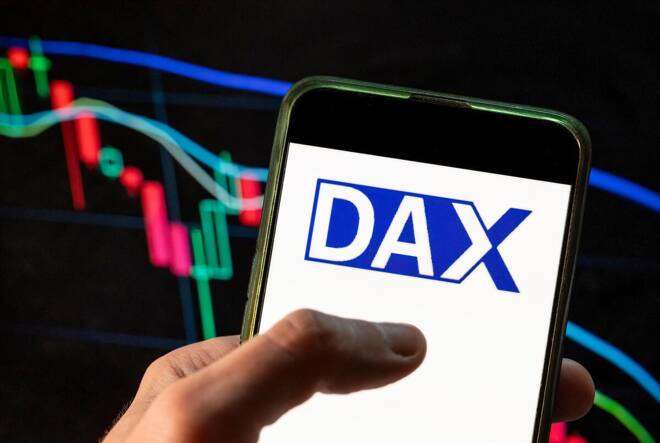Advertisement
Advertisement
DAX Index: German Business Confidence and the ECB Press Conference
By:
The ECB monetary policy decision and press conference are in focus on Thursday. A higher-for-longer ECB rate path could pressure the DAX.
Highlights
- The DAX rallied 1.58% on Wednesday, ending the session at 16,890.
- On Thursday, German business sentiment and the ECB will influence buyer appetite for DAX-listed stocks.
- US GDP and jobless claims also need consideration as bets on a March Fed rate cut fluctuate.
Overview of the DAX Performance on Wednesday
The DAX rallied 1.58% on Wednesday. Reversing a 0.34% loss from Tuesday, the DAX ended the session at 16,890.
German and Eurozone Private Sector PMIs and Corporate Earnings Impress
Ahead of the European session, news of the PBoC announcing a 0.5 percentage point cut to the Reserve Requirement Ratio set the tone. Beijing also said more stimulus measures are likely.
Improving manufacturing sector conditions across Germany and the euro area also supported the appetite for riskier assets.
The German Manufacturing PMI increased from 43.3 to 45.5, with the Eurozone Manufacturing PMI up from 44.4 to 46.6 in January.
German corporate earnings results supported the positive sentiment. Siemens Energy AG and SAP delivered strong results, fueling investor appetite for DAX-listed stocks.
US Services PMI Signals a Robust US Economy
On Wednesday, US private sector PMIs supported buyer appetite for DAX-listed stocks. The all-important US services PMI increased from 51.4 to 52.9 in January.
The US equity markets responded to the US economic indicators. On Wednesday, the Nasdaq Composite Index and S&P 500 ended the day up 0.36% and 0.08%, respectively. The Dow fell by 0.26%.
The Wednesday Market Movers
Siemens Energy AG and SAP led the way, surging 8.62% and 7.63%, respectively.
However, the auto sector had a mixed session with Tesla Inc. (TSLA) earnings in focus. Volkswagen gained 1.95%, with Porsche rising by 1.29%. Mercedes Benz Group ended the day up 0.85%, while BMW slipped by 0.01%.
Adidas ended the day in negative territory, falling 0.68%. Investors reacted to Puma warning of the effects of the Argentina currency devaluation on earnings. Puma shares plummeted 10.45% on Wednesday.
German Business Sentiment and the ECB
On Thursday, the German Ifo Business Climate Index will draw interest early in the European session. Economists forecast the Index to increase from 86.4 to 86.7 in January.
An improving business sentiment environment would support the buyer appetite for DAX-listed stocks. However, investors may wait for the ECB monetary policy decision and press conference before making decisive moves.
Economists expect the ECB to leave interest rates at 4.5%. However, there is market uncertainty about ECB plans to cut interest rates, putting the press conference in focus. We expect investors to react to forward guidance on the economy, inflation, and interest rates. A more hawkish-than-expected ECB rate path could impact buyer demand for DAX-listed stocks.
US Economic Calendar: Q4 GDP, Jobless Claims, and Corporate Earnings
On Thursday, US Q4 GDP and labor market numbers warrant investor attention. Better-than-expected GDP numbers and tighter labor market conditions could ease bets on a March Fed rate cut.
Economists forecast the US economy to expand by 2.0% in Q4 after growing by 4.9% in the third quarter. However, investors must consider contributions from consumer spending and trends in disposable income and inflation. Upward trends in disposable income and inflation could force the Fed to delay rate cuts. A delay to Fed rate cuts could affect the buyer appetite for riskier assets.
Amidst fluctuating bets on a March Fed rate cut, the weekly jobless claims could pressure the Fed to delay cutting rates. Economists forecast US initial jobless claims to increase from 187k to 200k in the week ending January 20.
Beyond the numbers, corporate earnings also need consideration. Visa Inc. (V) and Intel Corp. (INTC) are among the big names to release earnings results.
Short-term Forecast
Near-term trends for the DAX hinge on the ECB press conference and US inflation. A higher-for-longer ECB rate path and sticky inflation could pressure the DAX. However, investors must consider corporate earnings. Upbeat earnings results could counter immediate concerns about monetary policy and the economic outlook.
In the futures, the DAX and the Nasdaq mini were down 44 and 15 points, respectively. Investor apprehension about the ECB press conference likely influenced pre-European session trends.
DAX Technical Indicators
Daily Chart
The DAX held well above the 50-day and 200-day EMAs, sending bullish price signals.
A DAX break above the Wednesday high of 16,921 would give the bulls a run at the all-time high of 17,003.
On Thursday, German business sentiment, the ECB, the US economic calendar, and earnings need consideration.
However, a drop below the 16,750 handle would support a fall toward the 16,470 support level.
The 14-day RSI at 62.76 indicates a DAX return to the 17,000 handle before entering overbought territory.
4-Hourly Chart
The DAX sat above the 50-day and 200-day EMAs, affirming the bullish price signals.
A DAX return to the 16,900 handle would bring the January high of 16,964 and the ATH 17,003 into play.
However, a break below the 16,800 handle would support a fall toward the 50-day EMA.
The 14-period 4-hour RSI at 68.82 indicates a DAX return to the 16,900 handle before entering overbought territory.
About the Author
Bob Masonauthor
With over 28 years of experience in the financial industry, Bob has worked with various global rating agencies and multinational banks. Currently he is covering currencies, commodities, alternative asset classes and global equities, focusing mostly on European and Asian markets.
Latest news and analysis
Advertisement
